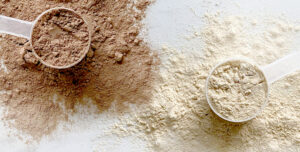A new study suggests that people can add more than 10 years to their lives by replacing a “typical Western diet” focused on red meat and processed foods with an “optimized diet” that revolves around eating more fruits, vegetables, legumes, whole grains, and nuts.
In addition to possibly helping people live longer, some other benefits of healthy eating include keeping skin, teeth, and eyes healthy, supporting a healthy immune system, and lowering the risk of heart disease, type 2 diabetes, and some cancers. Healthy eating may also help people maintain a healthy weight.
So, if you’re wondering, what does a healthy, balanced diet look like? Here are some healthy eating basics, as well as seven tips on eating a healthy, balanced diet in the real world.
Healthy Eating Basics
In America, 77% of people exceed the limit for saturated fat, 75% of people have dietary patterns low in vegetables, fruit, and dairy, and 63% of people exceed the limit for added sugars.
So, in order to “make every bite count,” the Dietary Guidelines for Americans recommends starting with these 4 Guidelines:
- Follow a healthy dietary pattern at every life stage.
- Customize and enjoy nutrient-dense food and beverage choices to reflect personal preferences, cultural traditions, and budgetary considerations.
- Focus on meeting food group needs with nutrient-dense foods and beverages, and stay within calorie limits.
- Limit foods and beverages higher in added sugars, saturated fat, and sodium, and limit alcoholic beverages.
While it’s important to follow the dietary guidelines and establish a healthy dietary pattern as early in life as possible, the good news is that it’s also never too late to improve your food and beverage choices.
What Does A Healthy, Balanced Diet Look Like?
A healthy, balanced diet includes eating lots of fruits and vegetables, consuming whole grain foods and protein foods, limiting highly processed foods, and drinking water since it promotes hydration without adding any calories to your diet.
At each meal, try to fill half of your plate with vegetables and fruits, a quarter of your plate with whole grain foods, and a quarter of your plate with protein foods.
Here are some examples of foods and beverages to include, limit, and avoid as part of a healthy, balanced diet.
Include:
- Fruits and vegetables
- Plant-based proteins
- Whole grains
- Beans and legumes
- Nuts and seeds
- Fish, especially oily fish with omega-3 fatty acids
- Skinless poultry and lean animal proteins
Limit:
- Sugary, sweetened drinks
- Saturated fats and dietary cholesterol
- Fatty or processed red meats
- Refined carbohydrates
- Full-fat dairy products
Avoid:
- Highly processed foods with a lot of sodium, like fast food and canned soups
- Trans fat and partially hydrogenated oils that are found in some commercially baked and fried foods
7 Tips On Eating A Healthy, Balanced Diet In The Real World
1. Make A Grocery List Before You Go Food Shopping
If you’ve ever gone grocery shopping without a list, especially when you’re very hungry, then you know just how tempting it can be to purchase foods and beverages that aren’t part of a regular healthy diet plan.
In fact, a study suggests that using a grocery list is associated with a healthier diet. That’s because a shopping list can serve as a memory aid, a guide to limiting impulse buys, and a formal planning method that structures meals and eating habits, according to the study.
Another study also found that hungry shoppers with lists did not make any more unplanned purchases than other shoppers, whereas hungry shoppers without lists did buy more than others. So, don’t leave home without your grocery list the next time that you go food shopping.
2. Cook And Eat At Home More Often
While most chain restaurants now post nutritional information, the average adult eats 836 calories per fast food meal and underestimates the amount of calories that they actually consumed by 175 calories.
By cooking and eating at home, you get to control the ingredients, preparation methods, and serving sizes. Studies have also shown that cooking and eating at home more frequently is associated with a better overall diet quality.
3. Eat A Wide Variety Of Foods
It’s fine to have a favorite meal or two, but make sure to switch up what you eat every now and again because variety is key when it comes to a healthy diet. By eating a wide variety of foods, you’ll be giving your body different nutrients, which may help prevent nutritional gaps.
So, eat the rainbow! Or, do your best to eat foods that naturally contain a wide variety of colors throughout the week.
4. Make Healthy Food Swaps
Some healthy food swaps that you can make that will cut a whole lot of calories from your daily diet are boiling your eggs instead of eating them scrambled with butter, opting for cinnamon raisin toast instead of traditional cinnamon buns, and swapping mayonnaise for mustard. Using lettuce as a bun instead of whole wheat hamburger buns can save you over 125 calories, as well.
So, as you can see, small changes can make a big difference in your diet. By making simple healthy food swaps whenever possible, you’ll be well on your way to eating fewer foods that are high in calories, fat, salt, and sugars – without a whole lot of extra effort needed!
5. Drink Water Instead Of Other Beverages
We all know how important it is to drink enough water every day in order to stay hydrated. After all, water helps maintain the balance of body fluids, helps energize muscles, and helps keep skin looking good. And since water has no calories and contains no sugars that can damage your teeth, it’s considered the healthiest choice for quenching your thirst.
If you’re trying to lose weight, a study suggests that increased water intake is associated with weight loss. Plus, research has also shown that drinking water before meals can reduce your appetite and food intake during your next meal.
6. Don’t Look At Screens While You Eat
A survey found that 88% of people eat while staring at some type of screen, such as their computer, smartphone, or TV. While it may not seem like such a big deal to check your phone while you eat lunch, or watch TV on the couch as you eat dinner, research shows that screen time while eating can “increase the amount of food you eat by 30 to 60 percent.”
So, put your phone away and turn off your computer or TV when you eat, and really focus on enjoying your meal. And if you have children, make sure that they do the same since a study found that using smartphones when eating increases caloric intake in young people.
7. Get Enough Sleep Each Night
If you’re wondering what sleep has to do with eating a healthy, balanced diet, there is extensive scientific research linking sleep deprivation to weight gain and obesity.
Sleep deprivation disrupts appetite regulation, which often leads to an increased appetite. And when you consume more calories than you burn, it can lead to weight gain.
Inadequate sleep has also been shown to be a contributor to obesity in both children and adults, according to an observational study.







